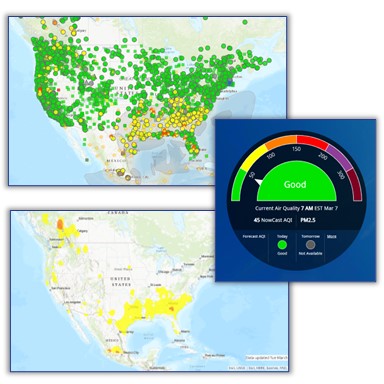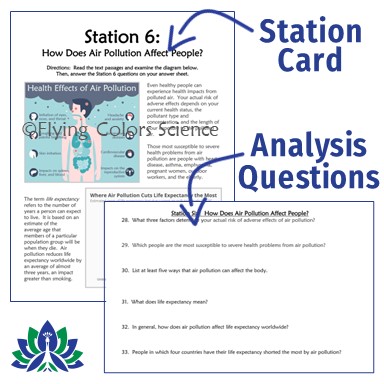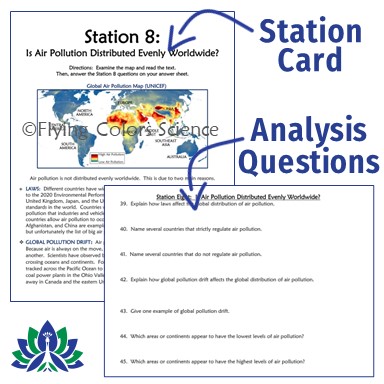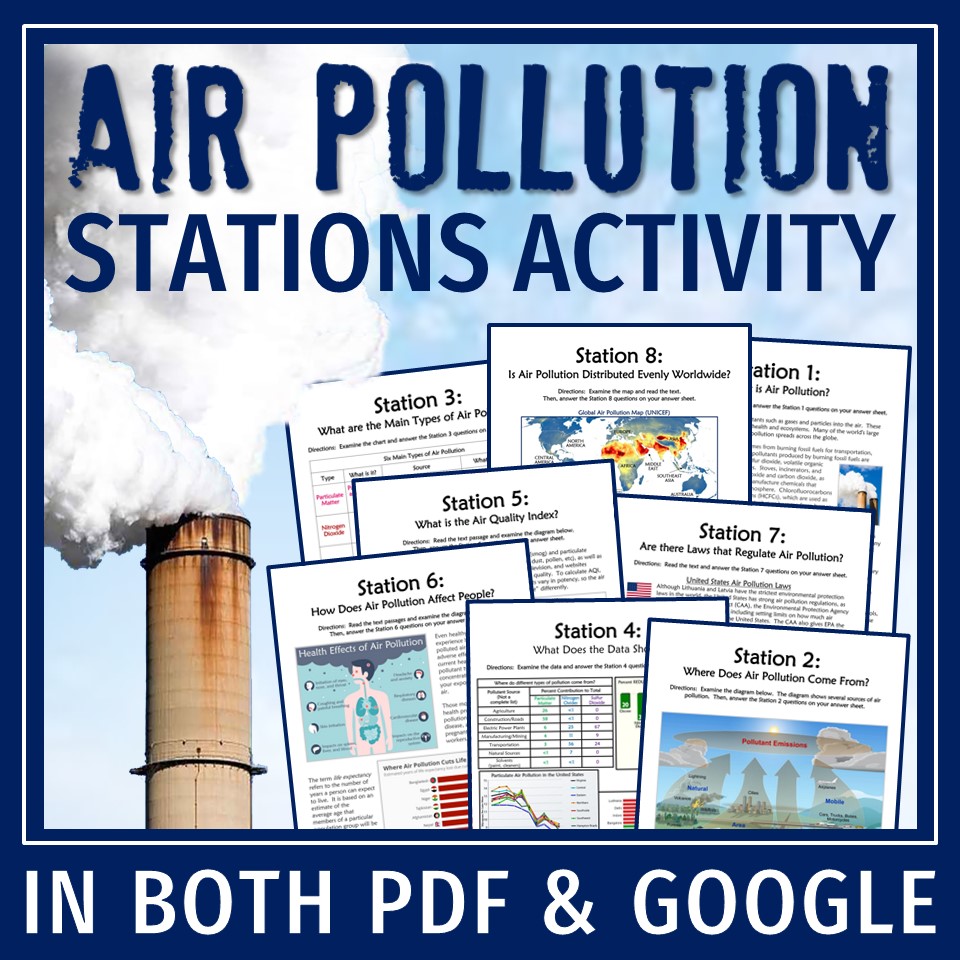
Whether you’re teaching human impact on the environment, ecosystems, Earth’s systems, climate change, or even chemistry, it’s easy (and important) to add an air pollution activity to your curriculum. Air pollution has natural ties to so many aspects of science, health, and even social issues. Students should understand how air pollution affects them and their local and global communities in a multitude of ways.
Over the years, I developed tried-and-true ways to teach air pollution in my science class. I’ll explain it all in this blog post. And read until the end, when I explain the new activity I’ll be adding this year!
If kids can’t see it, if they can’t feel it, if they can’t experience it… it’s hard to get them to care. So, the first step to teaching air pollution is to give kids VISUALS that grab their attention.
First, give kids actual, tangible (kind of!) evidence of air pollution, specifically particulate matter, from their own surroundings. If you have access to microscopes, this activity is a “must” to get kids’ attention for an air pollution lesson. The procedure is pretty simple:

Next, bring up the website https://www.airnow.gov/ for the students to see. This website allows you to plug in your school’s zip code and get real-time air quality for your area. There’s also a real-time fire map to view where smoke is an issue and an interactive map with overlays of current particulate matter and ozone levels. This activity doesn’t take long, but it’s another way to personalize air pollution as a local issue.

After getting the kids’ attention and interest with the visuals, I assign a very simple air pollution reading and questions. It’s not flashy, but it gets the job done! Students read a simple 1-page article about the top 10 sources of air pollution and then answer text-dependent questions.
Students will learn that the largest source of air pollution is the combustion of fossil fuels, how industries and agriculture contribute to air pollution, what VOCs are, and even how Earth’s natural processes contribute to air pollution. This reading gives kids a solid understanding of where air pollution comes from before we move on.

To get kids up and moving in my air pollution lesson, I created a stations activity. Students move from station to station, gathering information and answering questions on a worksheet. Eight air pollution stations are included. Students practice different skills at each station, all while learning about different aspects of air pollution. Station cards may include text passages to read, diagrams to analyze, data and graphs to explore, a map to interpret, or a timeline.



Kids love doing work like this because each task makes them feel accomplished. Put together, all of these stations have a ton of information and might be overwhelming. But when it’s broken up like this, each piece is manageable. Kids are reading text passages, they’re analyzing diagrams, they’re analyzing data – but they’re highly engaged, they’re discussing that material, and they’re collaborating. And I’m not the only teacher to say this… check out these reviews of my air pollution stations activity!
Another excellent resource! The variation in stations means students aren’t doing the same thing over and over and it also allows them to collaborate and move around the classroom. The product is high quality and helps students practice higher-order thinking skills using real-world data. – Chloe G.
LOVE LOVE LOVE! This resource was extremely easy to use and the students were very engaged. It is actually content-packed but my students were loving working on it. I especially like that they had to use their critical thinking skills at each station. Highly recommend! – Diana W.
Stations for the win! (Click the image below to view the product.)

This spring, I’m excited to add a new element to my air pollution lesson. As you may have figured out by now, I am a big fan of the activities that Karen of Science by Sinai offers. She and I discussed how we each cover pollution, and she told me about how she personalizes air pollution for her students. I’m in!
The premise behind this activity is that the students track their family car for a week, recording their trips and approximate mileage. They then classify the trips into 3 categories; necessary, luxury, or semiluxury. (Because I teach in a rural-ish area, driving is a part of every student’s life. However, Karen provides data for students who don’t have cars.)
Using this data, students do multiple graphing activities to visualize their habits. They break the information down into bar and pie graphs with daily averages and weekly averages. This naturally sparks a discussion about individual contributions to air pollution.
You know I love any opportunity to add graphing to my lessons, so I am excited to try this with my students!

If you like these ideas, please follow me on Instagram where I offer science teacher tricks and tips! And you can follow me on Teachers Pay Teachers, too!
As an Amazon Associate I earn from qualifying purchases.
© Flying Colors Science 2025 | Terms & Conditions | Privacy Policy | Disclaimer
| Cookie | Duration | Description |
|---|---|---|
| cookielawinfo-checkbox-analytics | 11 months | This cookie is set by GDPR Cookie Consent plugin. The cookie is used to store the user consent for the cookies in the category "Analytics". |
| cookielawinfo-checkbox-functional | 11 months | The cookie is set by GDPR cookie consent to record the user consent for the cookies in the category "Functional". |
| cookielawinfo-checkbox-necessary | 11 months | This cookie is set by GDPR Cookie Consent plugin. The cookies is used to store the user consent for the cookies in the category "Necessary". |
| cookielawinfo-checkbox-others | 11 months | This cookie is set by GDPR Cookie Consent plugin. The cookie is used to store the user consent for the cookies in the category "Other. |
| cookielawinfo-checkbox-performance | 11 months | This cookie is set by GDPR Cookie Consent plugin. The cookie is used to store the user consent for the cookies in the category "Performance". |
| viewed_cookie_policy | 11 months | The cookie is set by the GDPR Cookie Consent plugin and is used to store whether or not user has consented to the use of cookies. It does not store any personal data. |